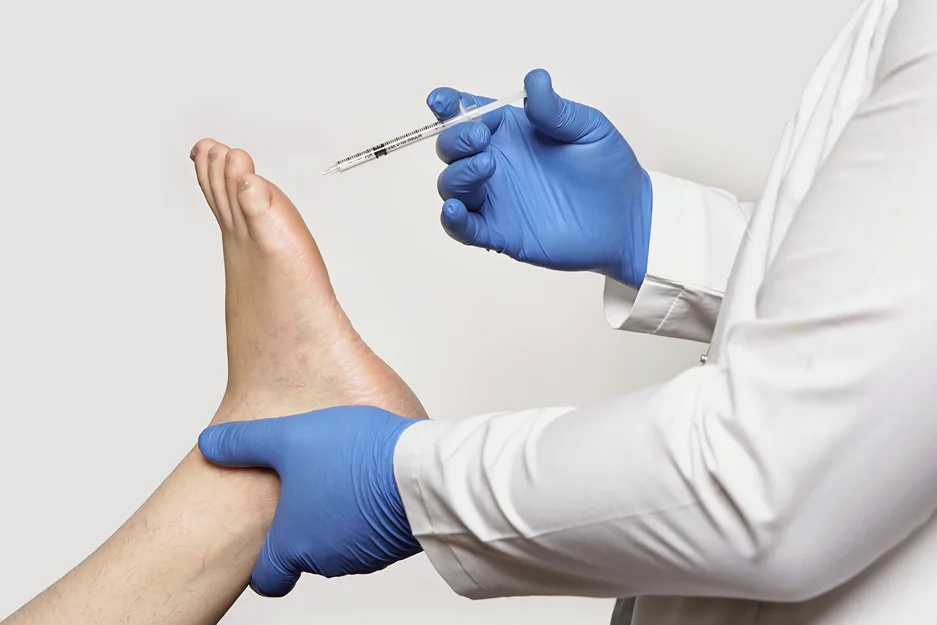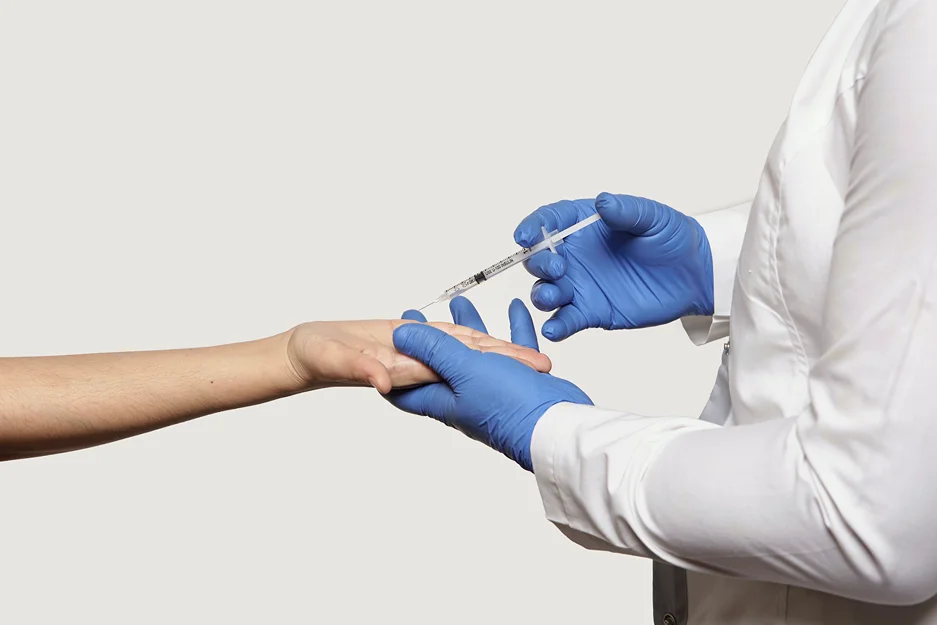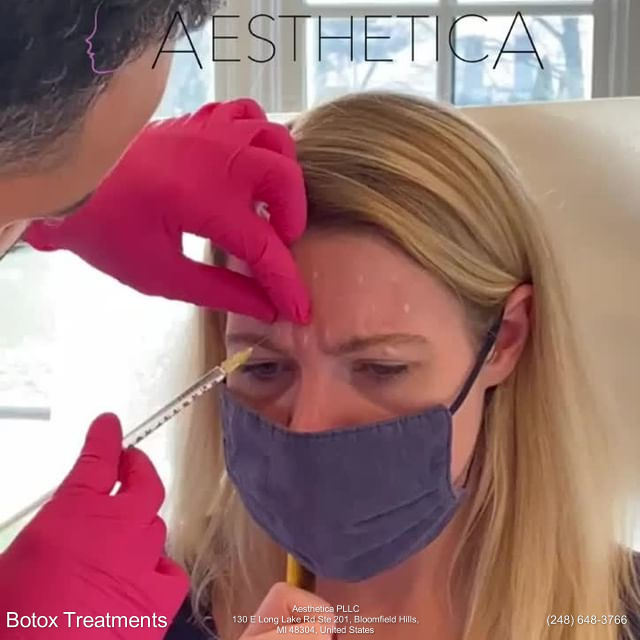
Problematic sweating can often be localized to a single part of the body, such as the armpits or feet, and this condition is known as primary focal hyperhidrosis. To counter this, Botox can be used as an effective treatment for focal hyperhidrosis aside from what it’s commonly known for – reducing cosmetic wrinkles. Botulinum toxin injections inhibit the nerve signals that cause sweating, preventing the sweat glands from producing excessive amounts of perspiration.
So how is Botox injected to treat excessive sweating? Botox is injected with very thin 30-gauge needles into muscles in doses that are appropriate for the body. Injections of botulinum toxin are most successful when hyperhidrosis is confined to one area of the body. It’s essential, however, that the procedure be performed by a licensed practitioner.
Aesthetica can assist you with all your beauty needs, helping you achieve your maximum beauty and aesthetic potential. Call or contact us today to learn more about our cosmetic services.
The nervous system triggers the sweat glands to help cool the body as the temperature rises. The nerves that control sweat gland activation are hyperactive in people with primary hyperhidrosis. Botulinum toxin works by blocking the production of acetylcholine near the sweat glands. Temporarily inhibiting this chemical that activates eccrine sweat glands turns off and stops sweating in affected areas.
Botulinum toxin treatment is a safe, effective, and well-tolerated procedure for axillary hyperhidrosis that should be considered by people who are affected by it. Those who don’t respond to topical treatments such as clinical-strength antiperspirants with aluminum chloride hexahydrate may find relief in regular Botox procedures.
Botox has a low risk, but like any medical procedure, it might cause complications. The simple answer is that any invasive therapy or surgery might have side effects or complications. Side effects of botulinum toxin include muscle weakness, discoloration, dry mouth, bruising, bleeding, and swelling.
A healthcare professional injects extremely little doses of Botox beneath the skin for the procedure. They commonly inject it in a grid pattern, spacing injection sites 1 to 2 cm apart. For 7 to 10 days before the Botox treatment of hyperhidrosis, patients are recommended to avoid taking blood thinners, aspirin, or other non-steroidal anti-inflammatory drugs, and high doses of vitamin E. These drugs may increase the risk of bleeding and bruising at the treatment site.
Botox injections are quick and painless. Botox is injected into targeted muscles with a tiny needle that causes only little discomfort. The majority of botulinum toxin injections are performed with very thin 30-gauge needles. Botox injections can be administered with some of the tiniest needles available (31- or 32-gauge), which reduces discomfort. For reference, the 32-gauge needle is nearly twice as thin as the 30-gauge needle.

Underarm Botox injections, according to the International Hyperhidrosis Society, can reduce excessive underarm sweating or axillary hyperhidrosis by 82% to 87%. The effects can continue anywhere from 4 to 12 months, with some cases lasting up to 14 months. The body retains the ability to cool itself through the other sweat glands that are not treated when the underarm sweat glands are eliminated or temporarily blocked from functioning.
Botox can also be used to reduce excessive sweating in specific areas such as the forehead, palms of the hands, and soles of the feet. Although due to discomfort, an injection of botulinum toxin in the feet and hands may require a nerve block. The treatment of palmar hyperhidrosis results don’t usually last as long compared to the treatment of excessive underarm sweating. Botox injections can help patients with primary hyperhidrosis temporarily relieve their symptoms.
Patients can also be treated with Botox if they experience excessive sweating in the groin or breasts. Although, they must ensure that skilled dermatologists perform this procedure. For a safe and successful severity-based treatment of hyperhidrosis, those who inject these regions must have a thorough understanding of the intricate muscles and tissues.
Botulinum toxin stops perspiration in the area where it’s injected by inhibiting or disrupting this chemical messenger. Botox injections are very shallow, meaning the drug is administered just beneath the skin's surface and remains there. The injection of botulinum toxin procedures must be administered by Botox-certified practitioners in controlled amounts to stop the effects of primary hyperhidrosis and inhibit eccrine sweat glands from producing excessive sweat.
To get the desired effect, a Botox needle can be injected into your muscles at various depths. Deep injections are those that go 6mm or deeper. Injections that are 2 to 5mm deep, beneath the epidermis, along with the overlying muscle and into the muscle group are considered medium.
Most clinics receive botulinum toxin as a dry powder. This is usually done in vials of 50 or 100 units. The powdered substance is then dissolved with saline solution as needed. When calculating how much Botox you're getting, keep in mind that the total number of units received should be taken into account and not the volume of Botox solution. How much Botox is diluted depends on the practitioner.
Botulinum toxin is injected directly into neuromuscular tissue after it has been diluted in saline. Although any injection can be uncomfortable, an injection of botulinum toxin is normally painless due to the small needle size used. Unfortunately, you won't know how uncomfortable the Botox injection will be for you until you receive it.
To alleviate discomfort, a topical anesthetic or ice pack can be applied to the treatment area before the injections. If you have any discomfort, bruising, or swelling following the injection, you can treat it with ice or cold compresses. Individuals suffering from primary hyperhidrosis who want Botox injections to address excessive sweating should seek out a licensed medical provider with sufficient experience.
Botox is dissolved by the body over time, and one treatment lasts, on average, 3 to 5 months. However, this might vary depending on a number of circumstances. It depends on the person, the number of units injected the person's metabolism, and how frequently you exercise vigorously.
Botox can take anywhere from 3 to 7 days after treatment for most people with hyperhidrosis to notice effects, while some individuals may take a little longer. The effects of Botox typically last 3 to 4 months. Smaller doses, as well as injections administered in regularly moving parts of the body, typically wear off quicker than larger doses (such as around the palms).
After 3 to 6 months, those who have treatment with botulinum toxin will discover that the effects are wearing off. Botox injections are used to temporarily paralyze the nerves that control specific eccrine sweat glands, eliminating and minimizing sweat in targeted regions. However, after a while, these effects will begin to fade and eventually fade away, allowing the sweat to return. It won't happen overnight, but it will happen gradually as the Botox wears off.
Botox works by paralyzing the point where the nerves connect to the muscles, causing the muscle to relax for an extended amount of time. New nerve endings emerge after a few months that are unaffected by Botox. When these are attached to muscles, the sweat glands open up and prompting sweat and (if not cleaned regularly) odor to return.
Botox is a temporary solution for primary hyperhidrosis, and it doesn’t completely cure excessive sweating. Botox contains botulinum toxin, which temporarily stops eccrine sweat glands from producing perspiration for a few months. There are different factors that can impact your Botox procedure results, including the treatment's effectiveness and duration.
A person's quality of life can affect Botox effects, especially when it comes to the amount of physical activity they engage in. Athletes may observe that the effects of Botox injections disappear more rapidly. This is related to the reason that an athlete's metabolism is substantially faster than that of an inactive person. Physically active individuals heal faster and eliminate Botox more quickly.
Botox has the potential to temporarily stop the secretion of a chemical that stimulates the eccrine glands in the entire body. However, the dosage of Botox doesn’t come in a one-size-fits-all package. The Botox treatment of primary hyperhidrosis should be suited to the level of activity, strength, and mass of your muscles. More Botox is required for larger muscles.
In order to produce the desired efficacy of botulinum toxin injections, patients with especially thick muscles will require extra Botox injections. Because bigger muscles are more difficult to stimulate with Botox treatments, additional injections are performed to ensure the best possible results.
The particular muscle being treated is another feature that can impact Botox results. Because you’re constantly moving around throughout the day, Botox and other neuromodulators wear off easily in the muscles that are used the most, such as the palms or feet. Additionally, the larger the muscle, the faster the effects will fade.
The injector's experience is a critical factor that can influence Botox results. If Botox is delivered too deeply, it may damage a blood vessel and cause skin bruising. Botox injected too superficially, on the other hand, can result in noticeable lines or lumps in the skin. As a result, you should only have Botox injections from a highly-skilled cosmetic practitioner.
One aspect that can have a favorable impact on Botox results is repetition. This is because continuous injections impair the sweat glands, which allows the efficacy of botulinum toxin injections to last longer. As a result, scheduling regular Botox injection consultations with your healthcare provider can help you achieve your long-term goals.
Botox is a non-invasive procedure with little to no downtime. However, there are certain aftercare guidelines that can help the injections perform at their best. While you can't control how quickly Botox is processed by your body, you can take steps to ensure that the treatments last as long as possible and that your results are maintained.
Direct sunshine causes your blood pressure to rise and your skin to flush. This can result in bruising around the injection site. After your operation, stay out of the sun for 48 hours. Tanning beds, saunas, hot tubs, and excessively hot baths should also be avoided.
After your treatment with botulinum toxin, try to leave the target area alone for at least 1 to 3 days. Massages, as well as tight clothes or hats, should be avoided because they may cause the injections to become dislodged. Avoid applying pressure on the treated parts of your body if you can.
Allow time for your new Botox injections to take effect. Exercise and other strenuous activities can cause Botox to spread to undesired regions, reducing the advantages you'll experience in the intended area. Before doing mild activities like running or easy yoga, wait 4 hours. Give yourself a full 24 hours before returning to your regular workout program.
As Botox belongs to an enzyme group that needs zinc for proper absorption, it’s recommended that patients take zinc supplements to help the body absorb the Botox. Zinc supplements, which contain phytase, may be beneficial to improving Botox injection results, especially in those individuals with a zinc deficiency.
Zytaze, a compound of zinc and phytase, has long-lasting effects on the patient's skin especially if taken 4 days prior to Botox injections.
Consult your doctor to see how often you can have Botox injections without risking your health. In order to avoid the development of resistance to botulinum toxin, injections should be spaced no more than 3 months apart. If you have Botox on a regular basis, you may be able to go for extended lengths of time between treatments, maybe up to 6 months. Follow-up Botox treatments ensure the long-term efficacy of the procedure.

Experienced practitioners inject small quantities of botulinum toxin into your muscles with a fine needle. The quantity of injections required is determined by a number of different factors, including the size of the treatment area and the severity of the condition. While Botox injections are usually painless, there are times when you may prefer your practitioner to numb your skin before they begin. Topical anesthetic, cold, or massage can all help with this.
If you believe Botox is the best treatment for your focal hyperhidrosis, it's critical to select a medical practitioner with Botox injection training, expertise, and success, like Aesthetica MI. Our preparations of botulinum toxin are up to FDA standards and administered only by highly-trained practitioners, so you don’t put yourself at risk of experiencing adverse effects. To address your concerns about excessive sweating, get in touch with us today.
Aesthetica can assist you with all your beauty needs, helping you achieve your maximum beauty and aesthetic potential. Call or contact us today to learn more about our cosmetic services.